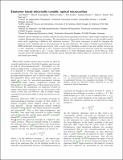Files in this item
Elastomer based electrically tunable, optical microcavities
Item metadata
| dc.contributor.author | Slowik, Irma | |
| dc.contributor.author | Kronenberg, Nils Michael | |
| dc.contributor.author | Franke, Markus | |
| dc.contributor.author | Fischer, Axel | |
| dc.contributor.author | Richter, Andreas | |
| dc.contributor.author | Gather, Malte Christian | |
| dc.contributor.author | Leo, Karl | |
| dc.date.accessioned | 2016-10-27T10:30:19Z | |
| dc.date.available | 2016-10-27T10:30:19Z | |
| dc.date.issued | 2016-10-26 | |
| dc.identifier | 246954108 | |
| dc.identifier | 8da3f7cc-66aa-45f4-9e01-b49fc0127305 | |
| dc.identifier | 84993967666 | |
| dc.identifier | 000387258300004 | |
| dc.identifier.citation | Slowik , I , Kronenberg , N M , Franke , M , Fischer , A , Richter , A , Gather , M C & Leo , K 2016 , ' Elastomer based electrically tunable, optical microcavities ' , Applied Physics Letters , vol. 109 , no. 17 , 171104 . https://doi.org/10.1063/1.4966549 | en |
| dc.identifier.issn | 0003-6951 | |
| dc.identifier.other | ORCID: /0000-0002-4857-5562/work/47136477 | |
| dc.identifier.uri | https://hdl.handle.net/10023/9712 | |
| dc.description | This work is supported in part by the German Research Foundation (DFG) within the Cluster of Excellence Center for Advancing Electronics Dresden (cfaed) and by the European Social Fund via the OrganoMechanics project. M.C.G. and N.M.K acknowledge support by the Scottish Funding Council (via SUPA) and the Human Frontier Science Program (RG0074/2013). | en |
| dc.description.abstract | Tunable optical elements are mostly realized by microelectromechanical systems, which require expensive and complex lithography during processing. We demonstrate an alternative device based on an electrically tunable microcavity employing a dielectric soft elastomer actuator. The cavity resonance is varied by changing the physical cavity thickness due to electrostriction of the soft elastomer. We realize a tunable metal-elastomerDBR multi-half wavelength microcavity with a cavity layer thickness around 12 µm and quality factors up to 700. Applying a voltage up to 60 V between bottom ITO and top metal electrode tunes the wavelength of the cavity modes up to ∆λ = 14 nm, which relates to a cavity thickness change of about 200 nm. This concept allows the implementation of tunable optical elements like tunable filters or resonators with low cost and simple processing. | |
| dc.format.extent | 5 | |
| dc.format.extent | 2532223 | |
| dc.language.iso | eng | |
| dc.relation.ispartof | Applied Physics Letters | en |
| dc.subject | QC Physics | en |
| dc.subject | TK Electrical engineering. Electronics Nuclear engineering | en |
| dc.subject | NDAS | en |
| dc.subject.lcc | QC | en |
| dc.subject.lcc | TK | en |
| dc.title | Elastomer based electrically tunable, optical microcavities | en |
| dc.type | Journal article | en |
| dc.contributor.institution | University of St Andrews. School of Physics and Astronomy | en |
| dc.contributor.institution | University of St Andrews. Biomedical Sciences Research Complex | en |
| dc.identifier.doi | https://doi.org/10.1063/1.4966549 | |
| dc.description.status | Peer reviewed | en |
This item appears in the following Collection(s)
Items in the St Andrews Research Repository are protected by copyright, with all rights reserved, unless otherwise indicated.

